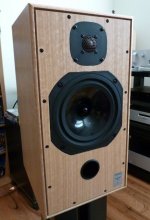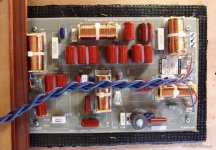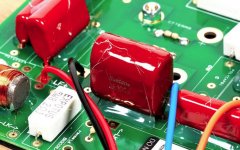All designers say always use air-core inductors for cross overs. I was wondering if any one has tried using ferrite core instead of air. and its performance.
I had seen some photos where Bose used ferite core. I once tried It made no audible difference to me.
Ferrite do not show huge non-linear behavior in the audio range. then why should those not be used in middle grade products.
The main benefit is size.
Less copper wire length so lower ESR.
Please share your views.
I had seen some photos where Bose used ferite core. I once tried It made no audible difference to me.
Ferrite do not show huge non-linear behavior in the audio range. then why should those not be used in middle grade products.
The main benefit is size.
Less copper wire length so lower ESR.
Please share your views.
You will find cored inductors used in quality monitors and professional loudspeakers that aren't peddling on the back of hifi ********.
Nought wrong with them in my opinion. They have the potential to saturate causing distortion and non-linearaties but properly specced this isn't a problem and as you pointed out for the same amount of inductance you get lower ESR everything else being equal.
Please share your views.
I consider it to be a matter of expense. Is the route of air cored
inductors worth the extra cost sound wise? I don't think so.
If you were to build a custom made product for a customer
who happens to believe in absolute audio purity, then it would
make sense to use air cored ones. Usually when an inductor
is saturated, the speaker units are probably also playing very loud
which doesn't come without increased distortion.
The cored inductors have lower magnetic field, less field interaction, lower DC resistance and more stable value with weather changes. So provided you design them to cope with the currents they will see, they are a great choice.
How can one tell when a particular cored inductor saturates?
Doesn't seem to be mentioned specifically in the specs.
Doesn't seem to be mentioned specifically in the specs.
They give current for the inductor. I believe that must be the sat current. But in my case i designed ferrite core with air gap. as this inductor was designed by me i did all the calculations for the saturation,
How can one tell when a particular cored inductor saturates?
Doesn't seem to be mentioned specifically in the specs.
When it starts losing its nominal inductance.
Visaton specifies saturation current.
Alas the people who supply me with inductors do not give a current. Just Henrys, DCR and physical size.
Even the suppliers I do not use don't give a current number.
One gives a power handling figure but it is so high (3000W) that I suspect that that is when the wire melts but I very well could be wrong.
Even the suppliers I do not use don't give a current number.
One gives a power handling figure but it is so high (3000W) that I suspect that that is when the wire melts but I very well could be wrong.
When it starts losing its nominal inductance.
Visaton specifies saturation current.
They do!
Thanks for that but one more question: Can I use that as a rough guide or does saturation vary dramatically from one inductor to another, all else remaining similar?
This is largely out of curiosity as I've built all the passive speakers I want to build already but I may change my mind on that one at some point in the future.
Last edited:
Read the document. Understand how inductor is designed. the current part and the material.
https://www.ti.com/lit/ml/slup127/slup127.pdf
Inductor is a part of designing the flyback trafo
https://www.ti.com/lit/ml/slup127/slup127.pdf
Inductor is a part of designing the flyback trafo
Alas the people who supply me with inductors do not give a current. Just Henrys, DCR and physical size.
Even the suppliers I do not use don't give a current number.
One gives a power handling figure but it is so high (3000W) that I suspect that that is when the wire melts but I very well could be wrong.
Inductors bought from electronics supply stores (Newark, Mouser, etc) always have saturation current as one of the principal specs right after Henry's. The audio places don't.
Inductors bought from electronics supply stores (Newark, Mouser, etc) always have saturation current as one of the principal specs right after Henry's. The audio places don't.
You're right, I checked with the electronics suppliers I've used (CPC Farnell, RS Components).
However they have limited values and high tolerances while the audio supplier I use (Falcon Acoustics) wind them to order at tighter tolerances and are actually cheaper to boot.
I have a DATS V2 speaker impedance tester from Dayton. $100 in U.S. And very good for measuring TS parameters. But I found that it is a very accurate (0.5%) LCR meter. I wind my own coils now with salvaged magnet wire from transformers scavenged from old appliances. It's also good for unwinding inductors to an exact value or for measuring unknown capacitances. LCR meters used to cost a lot.
And back on topic: at the power levels I deal with and typical uses, I found ferrite cores to sound just fine.
And back on topic: at the power levels I deal with and typical uses, I found ferrite cores to sound just fine.
Last edited:
Maybe that we engage our brains for a change...😀What's new here?
Firstly, the facts: ferrite cores increase inductance about four fold for a given air coil and wire resistance. Useful.
My own experience is that ferrite cores are good value for the sort of low levels we use in home audio. They are cheap and compact. Low resistance isn't actually a huge issue, because that is accounted for in the modelling and design.
I have misgivings about them in high Q notch filters which have bigger currents than is obvious, but into sensible loads and in bafflestep applications they work well enough. Of course, the lower the mH value on a given ferrite core, the less saturation (which is distortion and noise at some level) you have:
FC coils
It has been pointed out before that most modern speakers have ferrite cored magnets, so improving the bass coil is only a partial fix anyway.
To be the audio heretic, Alan Shaw of lovely Harbeth, below, uses measurably non-linear ferrites (well, they COULD be soft steel actually...IDK) along with MKT capacitors often enough. Even in tweeter filters. And why not? Take capacitors. If they have some series resistance in the filter arm, why spend money on low capacitor ESR (aka Equivalent series resistance) MKP types?
I do think it's possible to identify which crossover components are worth spending money on. And it depends on the reactive demands or Q of the circuit, IMO. The below last bass 1mH bafflestep ferrite of mine is only being asked to drive an impedance corrected woofer. Should work well enough. And it does. 😎
Attachments
Last edited:
ferrite core should allow lower DC resistance due to reduced wire length for the inductance
could have added core loss AC resistance terms
comparison to permanent magnet ferrite in the loudspeaker isn't useful - "hard" magnetic material vs "soft" the materials, magnetic operating regimes are completely different
fully poled hard ferrite permanent magnets look little different in magnetic "circuit " terms than empty air space
the small modulation of magnetic operating point doesn't flip domains to any extent or the magnet would be demagnetized in normal operation
could have added core loss AC resistance terms
comparison to permanent magnet ferrite in the loudspeaker isn't useful - "hard" magnetic material vs "soft" the materials, magnetic operating regimes are completely different
fully poled hard ferrite permanent magnets look little different in magnetic "circuit " terms than empty air space
the small modulation of magnetic operating point doesn't flip domains to any extent or the magnet would be demagnetized in normal operation
My experience says they can be used if correctly chosen.
I use Monacor ferrite cored inductors, which are wound on a roughly 1.5" core, and use stout wire (perhaps 1.6-2mm), for BSC and the saturation current is listed as 10 amps if I recall correctly. These work great.
I have used Murata ferrite inductors on a 20mm core which are rated at 5amps and these were easily saturated. Very bad. My semi educated guess is that this type is intended for SMPS power supplies as I have used the toroidal type, and these were awful too.
So I believe it is better to over spec the current rating by 2-3 times, and choose a larger core size with a ferrite, just in case.
I use Monacor ferrite cored inductors, which are wound on a roughly 1.5" core, and use stout wire (perhaps 1.6-2mm), for BSC and the saturation current is listed as 10 amps if I recall correctly. These work great.
I have used Murata ferrite inductors on a 20mm core which are rated at 5amps and these were easily saturated. Very bad. My semi educated guess is that this type is intended for SMPS power supplies as I have used the toroidal type, and these were awful too.
So I believe it is better to over spec the current rating by 2-3 times, and choose a larger core size with a ferrite, just in case.
- Status
- Not open for further replies.
- Home
- Loudspeakers
- Multi-Way
- Ferrite core instead of air core



